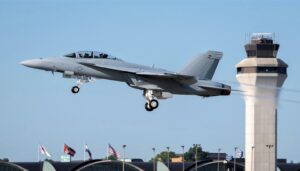Earlier breeding > more young birds > more strikes with aircraft BALTIMORE, Md. - Global warming may be involved in the explosive growth of certain bird populations, placing new pressure on airport wildlife control programs to mitigate the hazard of bird strikes to aircraft. Although couching the findings of a recent study as "preliminary," the peak risk of bird strikes at Dublin Airport, Ireland, has shifted to later in the year and the change appears related to climate change, said…
Contract Updates
USTRANSCOM has awarded a firm-fixed price (indefinite-delivery, indefinite-quantity contract) – $10,915,926.84,
USTRANSCOM has awarded a firm-fixed price, indefinite-delivery, indefinite-quantity contract, with a face value of $10,915,926.84, to SSA Atlantic LLC, Jacksonville, Florida, (HTC71126DE119). This contract provides Stevedoring and Related Terminal Services (S&RTS) in Florida, at the Ports of Jacksonville. The base…
The Boeing Co. (Ridley Park, Pennsylvania) – $183,163,191.00
The Boeing Co., Ridley Park, Pennsylvania, was awarded a $183,163,191.00 Firm-Fixed Price delivery order modification (Contract Number W91215-16-G-000 H9224122F0002 P00004) for procurement of H-47ER Rotary Wing Aircraft in support of United Kingdom Foreign Military Sales through U.S. Special Operations Command.…
CORRECTION: The contract announced on Dec. 15 2025 (for Southeastern Kentucky Rehabilitation Industries, Corbin) – $14,312,903
CORRECTION: The contract announced on Dec. 15, 2025, for Southeastern Kentucky Rehabilitation Industries,* Corbin, Kentucky (SPE1C1-24-D-N017) for $14,312,903 was announced with an incorrect award date. The correct award date is Dec. 17, 2025.
RGAS LLC (Houston, Texas) – $16,477,807
RGAS LLC,** Houston, Texas, has been awarded a maximum $16,477,807 firm-fixed-price, indefinite-delivery/indefinite-quantity contract under solicitation SPE4A7-25-R-0788 for various hydrofluorocarbon carbon gases. This was a competitive acquisition with five responses received. This is a one-year base contract with two one-year option…













